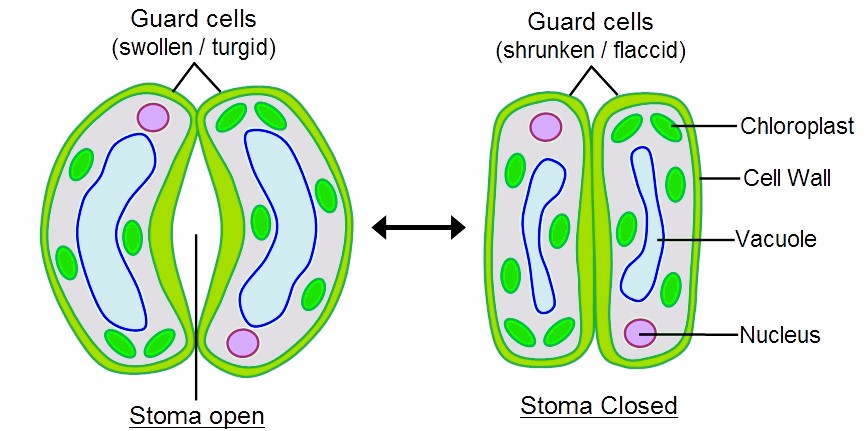
Guard Cell Diagram
The Guard Cells are a pair of kidney-shaped cells that surround the stoma. They have thicker outer walls and thinner inner walls, giving them the shape of a crescent. Inside the cytoplasm of the guard cells is a large vacuole that stores water. When the guard cells take in water, they expand and become Swollen (Turgid). This causes the inner walls to expand and the outer walls to bulge. The bulging outer walls cause the guard cells to separate and the stoma to open. Conversely, when the guard cells lose water, they shrink and become flaccid. This causes the inner walls to collapse and the outer walls to flatten. The flattened outer walls bring the guard cells closer together, causing the stomata to close.
Also Check – How do the Guard cells Regulate Opening and Closing of Stomatal Pores
Description of the labels in a Guard Cell Diagram
Guard cells ( Swollen / Turgid )- These specialised cells are found in the epidermis of plant leaves and stems. When they are swollen or turgid, it means that they are filled with water, causing them to expand and curve, resulting in the opening of the stomata.
Stoma Open- Stomata are small openings or pores in the epidermis of leaves and stems. The opening and closing of stomata is regulated by the turgor pressure of the guard cells. When the guard cells are turgid, the stomata open and allow gas exchange and transpiration.
Guard cells ( Shrunken / Flaccid )- When the guard cells lose water and shrink or become flaccid, they close the stomata. This closure helps to reduce water loss through transpiration and prevent excessive uptake of carbon dioxide.
Chloroplast- Chloroplasts are organelles found in plant cells, including guard cells. They contain chlorophyll, a pigment responsible for absorbing light energy during photosynthesis. Chloroplasts enable guard cells to use sunlight to produce energy and synthesises sugars, which is essential for their function.
Cell Wall- The cell wall is a rigid structure that surrounds the plant cells and provides them with support and protection. In guard cells, the cell wall helps to maintain the shape and structural integrity of these cells.
Vacuole- Vacuoles are large, membrane-bound organelles in plant cells. They play a crucial role in regulating the water content and turgor pressure of guard cells. When water enters the vacuole, the guard cells become Swollen (Turgid) and the stomata open.
Nucleus- The nucleus is the central organelle in a cell that contains the genetic material, the DNA. It controls various cellular processes, including the synthesis of proteins involved in the function of guard cells.
Also Check – Stomata – Definition, Structure, Functions , Location , Diagram and Types
Also Check – Mechanism of opening and Closing of the Stomata
Also Check – What are the function of Stomata
Also Check – What are the Components of Transport System in Highly Organised Plants
Also Check – What are the Methods used by Plants to get Rid of Excretory Products

One Comment on “Guard Cell Diagram”